-
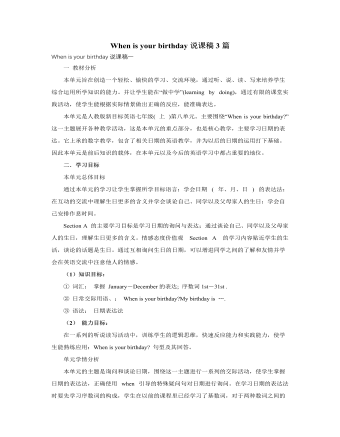
人教版新目标初中英语七年级上册When is your birthday说课稿3篇
一 教材分析 本单元旨在创造一个轻松、愉快的学习、交流环境,通过听、说、读、写来培养学生综合运用所学知识的能力。并让学生能在“做中学”(learning by doing),通过有限的课堂实践活动,使学生能根据实际情景做出正确的反应,能准确表达。本单元是人教版新目标英语七年级( 上 )第八单元。主要围绕“When is your birthday?”这一主题展开各种教学活动,这是本单元的重点部分,也是核心教学,主要学习日期的表达。它上承的数字教学,包含了相关日期的英语教学,并为以后的日期的运用打下基础。因此本单元是前后知识的载体,在本单元以及今后的英语学习中都占重要的地位。 二.学习目标本单元总体目标 通过本单元的学习让学生掌握所学目标语言;学会日期 ( 年、月、日 ) 的表达法;在互动的交流中理解生日更多的含义并学会谈论自己、同学以及父母家人的生日:学会自己安排作息时间。
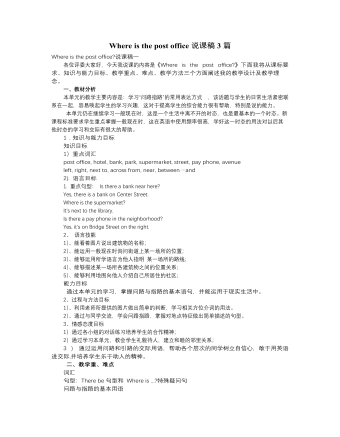
人教版新目标初中英语七年级下册Where is the post office说课稿3篇
Vocabulary:post office, restaurant, bank, supermarket, avenue, pay phone, park, dirty, clean, left, right, next to, across from, near, between, in front of, behindRecycling: hotel, street, new, big, small, busy, Do you want to…?Learning Strategies:Using what you knowDeducingPersonalizingSection ACreate plots and scenes to guide the new lessonThe main content is to learn to ask for and give directions in conversations by introducing some buildings in Section A, so we can adopt the Audiovisual Guiding Method: At first ,review the prepositions that the students have learned, then the teacher can teach some nouns about buildings by showing some pictures or projecting flashcards about some buildings.1. Show a picture of a bank.T:Look at this picture. What place is it ?S:It is a bank.T:Spell it.S: B-A-N-K .Teach other new words : post office, park, supermarket, payphone, street, .Show a map and let students practice in pairs.Is there …… ?Yes, there is. /No, there isn’t.2. Consolidation: Tell us the way to your school.T: Where is the …?S: It’s ….Teach the prepositionsNext to,across from,near,between,in front of,behind.Step1: .Learn some nouns about buildings first, and then the teacher communicates with the students.

人教版新目标初中英语八年级上册What are you doing for vacation教案2篇
Teaching goals : 1. Words & phrases: babysit ,get back , fishing , rent , think about , decide(on) , tourist etc. 2. How to talk about future plans . 3. 现在进行时表示将来计划或行动. 4. 特殊疑问句(where , when , how long引导) Important and difficult points : Drills :What are you doing for vacation ? I’m watching TV . When are you going ? I’m going … . How long are you staying ? We’re staying for five days . Teaching aids : cards and a tape ,a large wall calendar . Period 1 Teaching procedures : Step 1Leading in1. Free talk . 2. Put up the wall calendar . T: I’m staying home on Saturday (pointing to next Saturday ).Ss repeat . Ss: I’m staying home on Saturday . T: OK. Today we’ll learn how to talk about future plans. Step 2Pre-task SB Page 13 , 1a . 1. Look at the picture carefully and tell what you see in the picture . 2. Write the activities from the pictures in the box and add some more . 3. Practice reading . Step 3While-task1. Using the activities we write in 1a to make conversations .For example :What are you doing for vacation ? I’m visiting my uncle . 2. Pairwork .Practice in pairs . 3. 用第三人称练习对话.
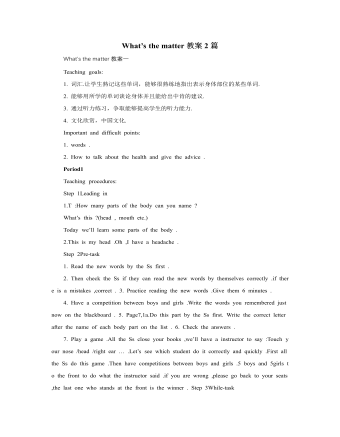
人教版新目标初中英语八年级上册What’s the matter教案2篇
She shouldn’t go to the party tonight.Step7. TaskT: You know, there are lots of problems in our life. If you are a doctor, please tell us how to solve the problem. I will divide you into 9 groups. Please work in groups. And then choose one of you to report your ideas.The following are the problems:I have a toothache.I am hungry. I have a sore throat.I am stressed out. I have a sore back.I am tired. I can’t sleep.I have a cold. I have a headache.Report: If you have a headache, you should go to bed early. You should see the doctor. You should eat some medicine. You shouldn’t wash your face with cold water.You shouldn’t sleep late.You shouldn’t swim.…..T encourages the students to give advice as much as possible.Homework:1. Chose one of the problems, and write down your advice2. Copy the new words这一步是用于热身的,同时也可以让他们复习一部分的表示人体部位的单词,扩充知识.学习语言的过程也是一个不断积累的过程,复习旧知识,增添新知识.通过小游戏,强化学生对Does she/he have…这个句子的运用能力.通过复习,自然的引到下面新知识的学习。充分利用表格,由句子到对话,再到文章,让学生循序渐进. 提高学生的综合语言运用能力,运用以前学过的知识来解决身边的问题.Period 5 (Section B 3a—3c, selfcheck)教学内容与分析:
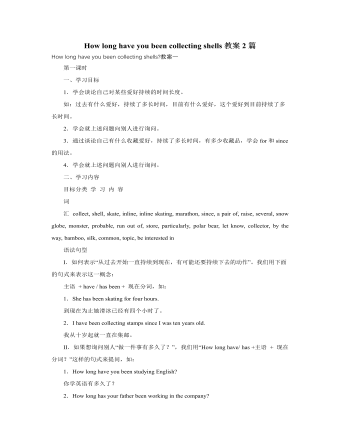
人教版新目标初中英语八年级下册How long have you been collecting shells教案2篇
Step Ⅱ Show the new words on the screen and teach the new words. Read the new words to students and ask them to repeat.Step Ⅲ 3aThis activity introduces new vocabulary and provides reading practice using the target language.In this activity first look at the four pictures.T: What can you see in the pictures?Ss: Four snow globes.T: Right. There are four snow globes in the pictures. And what are they?Ss: They are a monster, two polar bears, two penguins and a birthday cake.Write these words on the blackboard: snow globe; monster; polar bear; penguin and birthday cake. Read them to the class and ask students to repeat each one. Make sure students understand each word.Use a computer to show the E-mail message on the screen and read the message to students.Get students to read the e-mail on their own, and then draw lines connecting each snow globe and its description.Correct the answers.AnswersA line should connect each snow globe picture with the words that describe it in the letter.Step Ⅳ 3bThis activity provides writing practice using the target language.First review Activity 2a on Page 47.Then ask students to complete the message according to Activity 2a.Some partial sentences are given to students. Write about one person's collection.When students work, walk around the room checking the progress and offering help as needed.When they finish, ask some students to read their messages to the class.
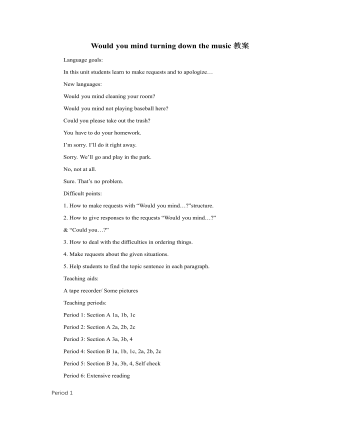
人教版新目标初中英语八年级下册Would you mind turning down the music教案
Step 4. Group work (4)1. Ask a pair of students to read the dialogue. Say, This activity provides speaking, listening and writing practice using the target language.2. Ask students to complete the work in groups.3. Check the answers with the whole class. 4. Explain some of the language points. Step 5. Word review (Self check 1)1. Ask students to read the words and the phrases given. 2. Fill in the blanks with proper forms of these words to complete the sentences. 3. Check the answers with the whole class. Homework:Do activity 2 on page 57 after class. Period 6Teaching aims: 1. Teach vocabulary words and the useful expressions. 2. Enable the students to learn etiquette in different culture. 3. Help the students learn how to behave politely in public places and in daily life. Teaching procedures:Step 1. RevisionHelp students to review the function of making requests through a free talk. Then lead them to the topic of etiquette. Explain the meaning of etiquette. Or, ask students to look it up in the dictionary. Step 2. Pre-reading (Section 1)1. Ask students to read the picture and make a list with their partner about how many rules of etiquette can be seen being broken.
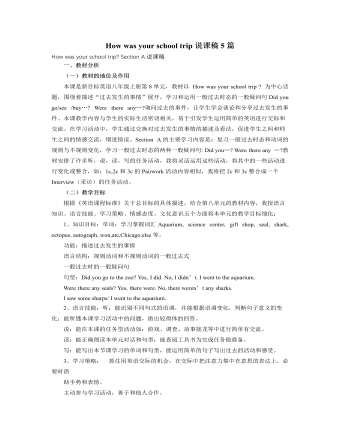
人教版新目标初中英语八年级上册How was your school trip说课稿5篇
If you are sandy,, you want to invite you good friends to come to you party, and you need their help, too..Make a list of things you want to buy and to do first, then discuss in group,act it out..让学生进行评价.评出有特色的“最佳表演”“最佳创意”“最…”小组,给予奖励。6.总结本课的target language.7.Homework.Invite your friends to have a picnic with you, and ask for their help to prepare for the picnic.. make a conversation. 8.教学反思如何激发学生的兴趣, 使他们主动积极地参与活动,开展合作学习, 使课堂充满活力,使设计的每个任务产生实效, 这是任务型教学中的首要问题. 本节课开展小组竞赛, 任务链为:游戏热身( 巩固词汇), 讨论(学习运用句型), 表演(综合运用)等活动, 逐步递进, 从简到难, 从谈论Sally 的周末, 到谈自己一周里所干的家务,电话邀请和请求帮助 ,都是来自现实生活的话题, 极具真实性. 为学生综合表达提供了丰富的素材.让学深入、让学生参与过程的评价体现了以学生为主体的教学理念.
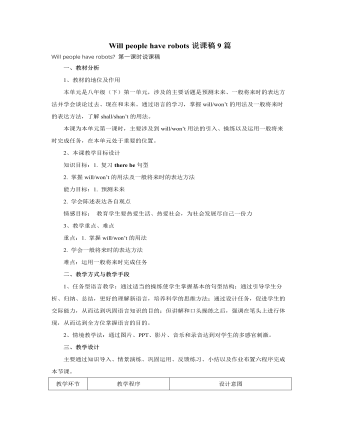
人教版新目标初中英语八年级下册Will people have robots说课稿9篇
(一) 导入新课(1’)运用多媒体课件,播放有关机器人的视频,引起学生共鸣,激发学生学习兴趣。 边看边展示与课文相关的新单词。让学生想像机器人都是什么样的,机器人能做什么?(这样导入新课,自然创设学习情景,引起学生共鸣,引起学生的兴趣。)(二)快速阅读(skimming)(4’)任务:让学生带着要求快速阅读课文:Get the main idea of the whole passage.这个环节是让学生初读课文,目的是训练快速阅读技巧,学生以较快的速度完成阅读,迅速找到答案。(学法指导:注意:用浏览、跳读和快读的技巧,培养自己快速获有用信息的能力---抓住关键词、主题句和中心大意的能力。Tips: Reading for meaning , not for details(细节).不必逐行阅读(三)深层阅读(5’)任务一:默读文章,回答下列问题,我利用多媒体出示2个问题,(把2个问题打出来)然后让学生带着问题进行有目的阅读。(这样做可以充分利用课本资源,而且化难为易.在全班校对答案之前我让学生先进行同桌相互校对,充分发挥生生互动。)
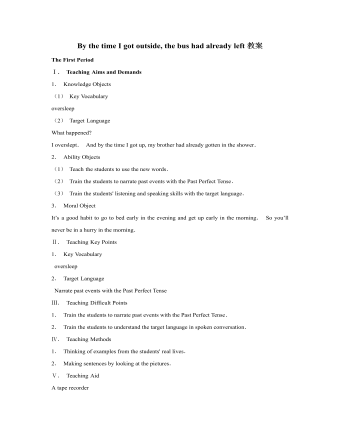
人教版新目标初中英语九年级下册By the time I got outside, the bus had already left教案
Ⅰ. Teaching Aims and Demands1. Knowledge Objects(1) Key Vocabularyoversleep(2) Target LanguageWhat happened?I overslept. And by the time I got up, my brother had already gotten in the shower.2. Ability Objects(1) Teach the students to use the new words.(2) Train the students to narrate past events with the Past Perfect Tense.(3) Train the students' listening and speaking skills with the target language.3. Moral ObjectIt’s a good habit to go to bed early in the evening and get up early in the morning. So you’ll never be in a hurry in the morning.Ⅱ. Teaching Key Points1. Key Vocabularyoversleep2. Target LanguageNarrate past events with the Past Perfect TenseⅢ. Teaching Difficult Points1. Train the students to narrate past events with the Past Perfect Tense.2. Train the students to understand the target language in spoken conversation.Ⅳ. Teaching Methods1. Thinking of examples from the students' real lives.2. Making sentences by looking at the pictures.Ⅴ. Teaching AidA tape recorderⅥ. Teaching ProceduresStep I Revision1. Revise the language points in Unit 8.Ask some questions like this: What volunteer work would you like to do?Help the students to answer, I’d like to…/I love to…/I hope to2. Practice the dialogue in Activity 3c on page 62 again. Get students to role play the similar dialogues with the following.

人教版新目标初中英语九年级上册I used to be afraid of the dark说课稿4篇
2、说说写写通过读写训练,进一步学会用 used to 结构来表达自己和同伴过去害怕,或现在仍旧害怕的事情,并且要把最后的结果书写下来,然后让他们将结果用英语告之其他同学,为学生创造展示才能的机会。这样能使全体同学都积极参与,集中精力认真听。既巩固了本节课的目标语言,又为下一个环节3b的对话打下基础。活动结问题比较容易,英语基础较差的学生也能够独立完成,因此,在检查答案是尽量让这部分学生回答,使他们体验到成功后的喜悦,提高他们学习英语的兴趣。 3.对话练习:让学生两人一组,模仿3a中的对话,根据提供的信息与提示词进行对话练习,目的在于对新学的目标语言进行口头练习与设定情景中的运用。为学生创造展示才能的机会。推荐两至三组的同学到教室前面,就所编的对话进行角色表演。
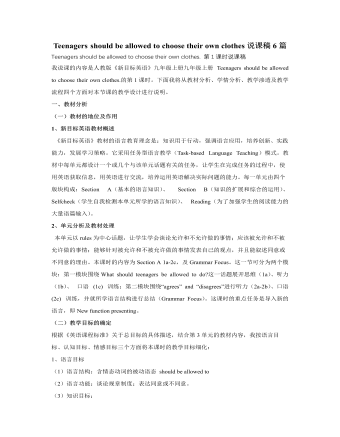
人教版新目标初中英语九年级上册Teenagers should be allowed to choose their own clothes说课稿6篇
二、教材分析本课时主要是以听和说的方式来谈论一些家庭和学校的“规矩和制度”,知道那些时可以做的,那些是不可以做的,让学生先从口头上了解这些规矩和制度,为后面的学习做好准备。三、教学的目的和要求1. 掌握短语be strict with sb.的用法,并介绍be strict in sth.的用法;2. 学生能够根据所学的知识,了解用什么方式/句型来制定规章制度。3. 多听,提高学生的习愿望,敦促学生开口说英语,用本课所学的知识来表达自己的意见。四、教学重点和难点1. 如何正确使用be allowed to do…这一句型(在不同时态中的被动语态运用)。2. 如何获得听力技巧及口语技能的提高。五、教学过程T—teacher S—studentS s—students Bb—blackboardStep 1 Warming up Check their homework first, and see if the Ss can make sentences by using the rules in 4, Section A. If possible, try to give some help.
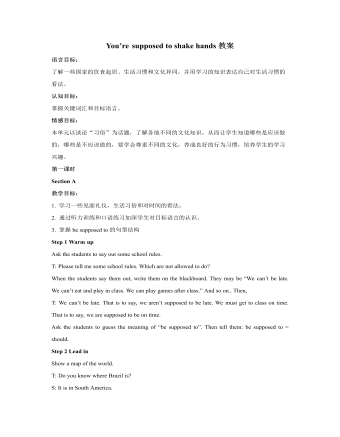
人教版新目标初中英语九年级下册You’re supposed to shake hands教案
教学目标:1. 掌握本单元一些重点词汇的写法和用法。2. 学会自如谈论餐桌礼仪。Step 1 RevisionAsk some students to retell the customs at the table in France in the passage in 3a.Step 2 Self checkPart 1. Fill in each bland with the correct word given. Students do the exercises by themselves at first. Then check the answers. Ask the students to comprehend the sentences and help them point out uses of some words, like “arrive (at / in) sw., spend time / money on sth , spend time / money (in) doing sth.”Part 2. Read about Fan Ling’s experience in a western restaurant. Understand the passage. Point out some key points in the passage.1. be / get used to doing sth. 习惯做某事2. begin with = start with 以….开头3. crowd v. 挤满,塞满 the crowd 人群 crowded adj. 拥挤的Then students discuss about how she would solve her problem. Ask some to share their stories with others.Part 3. Complete the crossword by looking at the sentences on the left. Then check the answers.
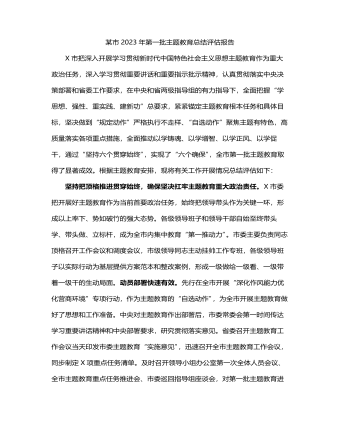
某市2023年第一批主题教育总结评估报告
强力调度开展专项整治。X市委主要负责同志主持召开主题教育专项整治工作会议,制定印发X个方案,组建X个工作专班,各单位共确定X个专项整治任务,以台账式管理、项目化推进、销号式落实,确保专项整治见底到位。媒体广泛报道公示接受监督,在《X日报》显要位置公布专项整治事项、举报受理方式,在政务网站、各单位AAA公众号增设举报专区,真正把专项整治置于社会和群众监督之下,避免自说自话、体内循环。开展电视问政倒逼落实,在X电视台《问政X》栏目分X期开展专题问政,相关专班牵头部门主要负责同志现场回应热点关切,网络直播收看量超过X.X万。直播过程中,同步收集群众在网络平台上提出的问题和建议X个,纳入市委、市政府督查重点内容,跟进督促整改到位。举办擂台比武加压奋进,召开市级主题教育专项整治调度会,X个专班牵头部门主要负责同志逐一述职进行“擂台比武”,与会人员对各专班工作进行评价,现场公布评价结果排名。
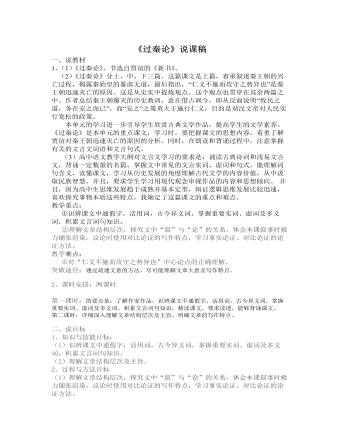
《过秦论》说课稿 2021—2022学年统编版高中语文选择性必修中册
三、教学方法为了突出重点,突破难点,完成教学目标,选择行之有效的教学方法是非常关键的。根据课程标准的要求和本节课的特点,为了关注学生的个体差异和不同的学习需求,充分调动学生学习的积极性,培养学生阅读和分析文章的能力,我主要采用以下的教学方法:1、悬念导入法。用悬念导入能激发起学生对文言文阅读的兴趣,充分调动学生学习的主动性。2、根据教师主导作用与学生主动性相结合的原则,选择了以语言传递信息为主的方法,讲授法。四、学法通过初中的学习,学生对古文知识已经有了一定的掌握,但是对这种古代散文比较少见,特别是叙史和议论结合的写法更是陌生。所以学习这篇课文的时候,通过反复地诵读,分析句型,对比句型的意思,达到疏通文意,这样,学生通过朗读理解法、质疑提问法、自主讨论探究法能复述课文,了解文章层次,理解文章主旨含义。
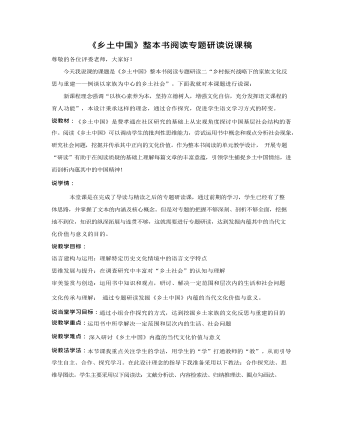
《乡土中国》说课稿 2021-2022学年统编版高中语文必修上册
活动一:整体感知,梳理要点新修订《课程标准》指出:重视学生的思维发展与提升,如直觉思维、形象思维、抽象思维等。为此,我设计了“梳理要点、绘制思维导图”两个部分,引导学生在阅读中整体感知文本。1、梳理章节要点,明确内容要素《家族》:以西洋家庭特点为对照,分析中国乡土社会家庭的特点。《男女有别》:主要讨论乡土社会感情定向的问题,偏向同性交往,遏制男女交往。2、展示思维导图,凸显整体关联引导同学制作多种思维导图:流程图式、树状图式、爪形图式活动二:走进文本,深化认知新修订《课程标准》指出:学会语文运用的方法,有效地提高语文能力,并在学习语言文字运用的过程中促进方法、习惯及情感、态度与价值观的综合发展。所以在教学中我引导学生掌握整本书阅读的基本方法,即以速读、跳读的方式地毯式地搜索书中关于“中西家庭差别”的内容,得出乡土家族的六个方面的特点,学生分别结合生活中的现象阐述了这六个方面的特点在生活中的具体体现。
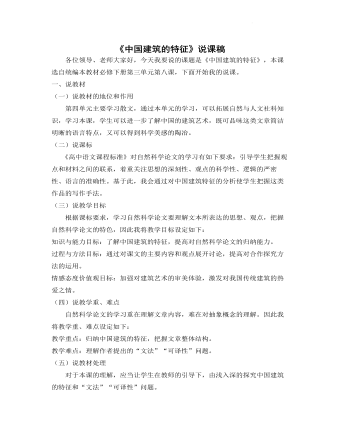
《中国建筑的特征》说课稿 2021—2022学年统编版高中语文必修下册
(二)初读课文,整体感知首先教师对作者进行简单介绍,再要求学生速读课文,让学生初步感知课文内容,归纳全文思路,边读边思考PPT上的问题。问题:全文可以分成几部分?此环节意在激发学生的学习主动性,培养学生的自学能力。读毕,我会对学生的自学情况进行检查反馈,鼓励学生踊跃发言,说出自己理解的写作思路,最后教师对学生的答案进行概括和总结,此环节能够让学生对中国建筑的特征整体把握,夯实学习本文的基础,同时感知课文,理清文章脉络,实现长文短教,为析读本文作好铺垫。(三)析读课文,质疑问难此环节是教学的重要阶段,在这里,我会以新课标为基准,做到阅读指向每一个学生的个体阅读,同时在教学过程中遵循启发性,循序渐进性的原则。此环节运用小组合作学习法、讨论法和问答法分析中国建筑的特征。同学每四人为一小组讨论PPT上展示的问题。
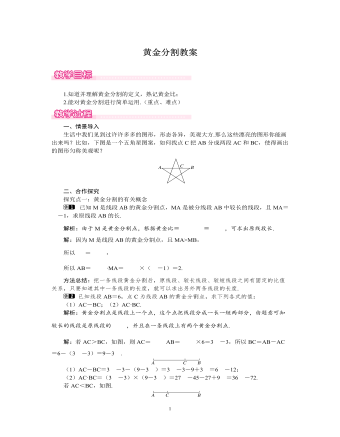
北师大初中数学九年级上册黄金分割1教案
解析:想要看起来更美,则鞋底到肚脐的长度与身高之比应为黄金比,此题应根据已知条件求出肚脐到脚底的距离,再求高跟鞋的高度.解:设肚脐到脚底的距离为x m,根据题意,得x1.60=0.60,解得x=0.96.设穿上y m高的高跟鞋看起来会更美,则y+0.961.60+y=0.618.解得y≈0.075,而0.075m=7.5cm.故她应该穿约为7.5cm高的高跟鞋看起来会更美.易错提醒:要准确理解黄金分割的概念,较长线段的长是全段长的0.618.注意此题中全段长是身高与高跟鞋鞋高之和.三、板书设计黄金分割定义:一般地,点C把线段AB分成两条线段AC 和BC,如果ACAB=BCAC,那么称线段AB被点 C黄金分割黄金分割点:一条线段有两个黄金分割点黄金比:较长线段:原线段=5-12:1 经历黄金分割的引入以及黄金分割点的探究过程,通过问题情境的创设和解决过程,体会黄金分割的文化价值,在应用中进一步理解相关内容,在实际操作、思考、交流等过程中增强学生的实践意识和自信心.感受数学与生活的紧密联系,体会数学的思维方式,增进数学学习的兴趣.
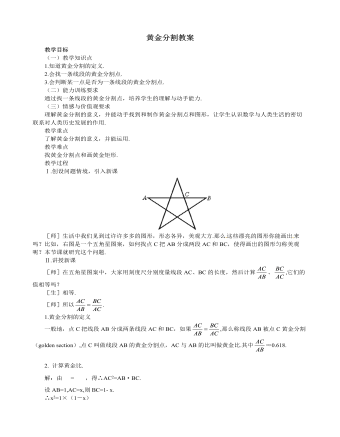
北师大初中数学九年级上册黄金分割2教案
2.如何找一条线段的黄金分割点,以及会画黄金矩形.3.能根据定义判断某一点是否为一条线段的黄金分割点.Ⅳ.课后作业习题4.8Ⅴ.活动与探究要配制一种新农药,需要兑水稀释,兑多少才好呢?太浓太稀都不行.什么比例最合适,要通过试验来确定.如果知道稀释的倍数在1000和2000之间,那么,可以把1000和2000看作线段的两个端点,选择AB的黄金分割点C作为第一个试验点,C点的数值可以算是1000+(2000-1000)×0.618= 1618.试验的结果,如果按1618倍,水兑得过多,稀释效果不理想,可以进行第二次试 验.这次的试验点应该选AC的黄金分割点D,D的位置是1000+(1618-1000)×0.618,约等于1382,如果D点还不理想,可以按黄金分割的方法继续试验下去.如果太浓,可以选DC之间的黄金分割 点 ;如果太稀,可以选AD之间的黄金分割点,用这样的方法,可以较快地找到合适的浓度数据.这种方法叫做“黄金分割法”.用这样的方法进行科学试验,可以用最少的试验次数找到最佳的数据,既节省了时间,也节约了原材料.●板书设计
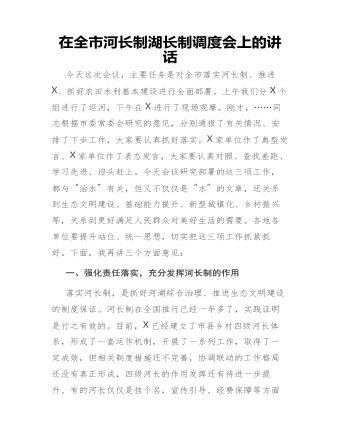
在全市河长制湖长制调度会上的讲话.
落实河长制,是抓好河湖综合治理、推进生态文明建设的制度保证。河长制在全国推行已经一年多了,实践证明是行之有效的。目前,X已经建立了市县乡村四级河长体系,形成了一套运作机制,开展了一系列工作,取得了一定成效,但相关制度措施还不完善,协调联动的工作格局还没有真正形成,四级河长的作用发挥还有待进一步提升、有的河长仅仅是挂个名,宣传引导、经费保障等方面还不到位。
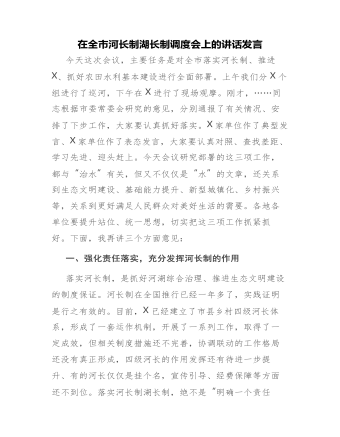
在全市河长制湖长制调度会上的讲话发言
一、强化责任落实,充分发挥河长制的作用落实河长制,是抓好河湖综合治理、推进生态文明建设的制度保证。河长制在全国推行已经一年多了,实践证明是行之有效的。目前,X已经建立了市县乡村四级河长体系,形成了一套运作机制,开展了一系列工作,取得了一定成效,但相关制度措施还不完善,协调联动的工作格局还没有真正形成,四级河长的作用发挥还有待进一步提升、有的河长仅仅是挂个名,宣传引导、经费保障等方面还不到位。落实河长制湖长制,绝不是“明确一个责任人、竖立一块公示牌”就万事大吉,必须通过一套行之有效的制度措施,通过一系列较真碰硬的具体工作,推动河湖综合治理取得实实在在的成效。


